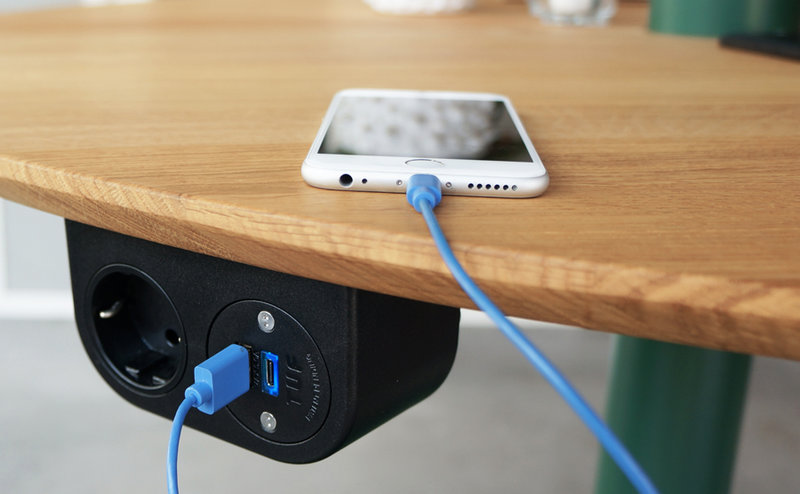Company Insight
CANI: Czech Air Navigation Institute
High-Density Seating Makes a Difference
The Czech Air Navigation Institute (CANI) established under the Air Navigation Services of the Czech Republic and located in Prague is a modern fully-equipped Air Navigation Services Training center with 30 years of industry and Air Traffic Control training experience. Our strong customer focus, multi-national team of qualified instructors, deep domain knowledge and friendly staff make CANI the training provider of choice for many Air Navigation Service Providers from Europe and beyond.
Company Insight
Sponsored by Green Furniture Concepts
Digital Nomads Inspire New Airport Design
Klaus Dengler, Managing Director Europoles Suisse GmbH), René Vuillemin, (Managing Director Europoles Suisse GmbH)
Do we live in an age where distance is becoming an illusion? Air travel is bringing far-off destinations ever-closer, while communication technologies are shrinking the space between office and worker. At a time when nomadism is emerging as the new norm, more travellers are working on the fly.
Business culture is on the brink of a revolution, with radical changes beginning to reshape the way we live, work and travel. Workers may operate from home or share co-working spaces, or pop up laptops in public to access open networks.
Commuters benefit from wireless access and recharging points, and many transport hubs offer digital hotspots for all. Compact surfaces designed for portable devices are standard features on many buses and trains, enabling passengers to work as they travel towards their destination. Yet, as bus and rail operators acknowledge that work and travel are merging into one, airports are less likely to meet the needs of ordinary passengers who work wherever they go.
Digital nomads are characterised by a highly mobile, international lifestyle, and skillsets that enable them to work remotely. The group includes entrepreneurs, freelancers, programmers and developers, each one citing the use of digital devices as an essential part of the mobile lifestyle.
Meet The Digital Nomads
The term was coined by Tsugio Makimoto in his 1997 book ‘Digital Nomad’. A decade later, the group emerged in response to the gig economy and the availability of low-cost air travel. Young professionals took advantage of flexible, freelance contracts, with those able to work off-site often relocating to hip destinations. Local entrepreneurs set up co-working and co-living spaces especially for digital nomads, some even expanding internationally. Community members typically work in digital media, or rely on portable devices to carry out professional tasks. Collectively, they consume more devices and digital services than any other demographic, and reside in areas where living costs are low and quality of life is high.
Always on the move, digital nomads have little in common with business travellers enjoying the luxuries of airport lounges. Used to working almost anywhere, digital nomads can transform café tables into workstations, or commandeer standing-height surfaces for use as individual desks. With airports more likely to provide workstations for business lounges than for terminals and gates, digital nomads compete with F&B customers, families and groups for surfaces where devices can be placed. Added to that, many report that recharging points are hard to find or difficult to access, and that most terminal environments are inhospitable places to work.
When life is good, digital nomads make loyal brand ambassadors. Surveys and reports circulate freely within the community, and individuals update blogs and Twitter feeds with links to destinations and services. As community members encourage each other to seek new adventures, they also warn of facilities that don’t support digital lifestyles. Airports often fall short of good reviews, typically criticised for disenfranchising digital nomads rather than equipping terminals with the basics the group need.

Image courtesy:
Title goes here
Nomads, like all working travellers, are used to sharing tables and seating, which makes individual workstations especially prized. Digital nomads rarely attend meetings or pitches in person, so they need quiet corners away from terminal noise where they can be heard on Skype. Acoustic surfaces can dampen sound and divide space, giving passengers a greater sense of privacy as they make calls. Cordless charging interfaces enable digital nomads to connect and recharge while they work, eliminating the nuisance of cables trailing towards power points.
Digital nomads travel light, typically booking a ‘carry-on only’ option rather than paying to check luggage in. Nomads are likely to make key purchases at airports, subsequently spending more in the terminal than individual holidaymakers do. Accessory brands are reaching out to nomads with lightweight, streamlined bags designed with secure compartments for laptops and devices. Fashion brands are targeting them too, offering comfortable, crease-proof clothing in versatile designs that combine practicality with everyday cool.

Image courtesy:
Even the colour palettes used in passenger areas can make the digital nomad’s experience more satisfying. Design-conscious nomads like to feel inspired, and colour concepts that soften dense airport architecture often make terminal environments more appealing. Colour-coding digital hotspots helps all passengers identify them more easily, even enabling the hotspots to double as way-finders that signal the route to the gates.
Today, the rise of digital nomads can no longer be ignored. Experts claim that their population may be doubling each year, with a recent study revealing that 4.8 million Americans consider themselves to be digital nomads. By 2035, European experts predict that there will be one billion digital nomads worldwide. As this consumer group continues to grow, the demand for digital services will soar to new heights. If airports can make terminals environments easier to work in, all passengers will benefit from the digital facilities they’ll offer.
When Design Goes Digital
- Wireless chargers are integrated into café tables and seating units.
- Colours and materials make digital hotspots easier to identify.
- Individual tabletops make it easier to open and operate devices.
- Acoustic materials dampen noise as they screen off workstations.
- Standing-height tables can direct the flow and keep passengers moving.
High-density seating makes more floor space available while providing up to 50% more seats. There’s more space for commercial traffic and far less congestion at gates.
About Green Furniture Concept
Green Furniture Concept designs seating and lighting for public interiors. Sustainability guides all development and is part of the company’s soul.
The modular seating series Nova and IOU give you the flexibility to create configurations as unique as your space, with the potential to offer room for both interaction and privacy. Leaf Lamp is an ambient, noise-filtering and flameproof lighting solution that mimics the organic designs found in nature and is made entirely of natural materials.
Tel: +46 (0)40 6009330
Email:info@greenfc.com
Website:www.greenfc.com
Image courtesy:
Yusuf Akçayoğlu, CEO of İGA Airports Construction